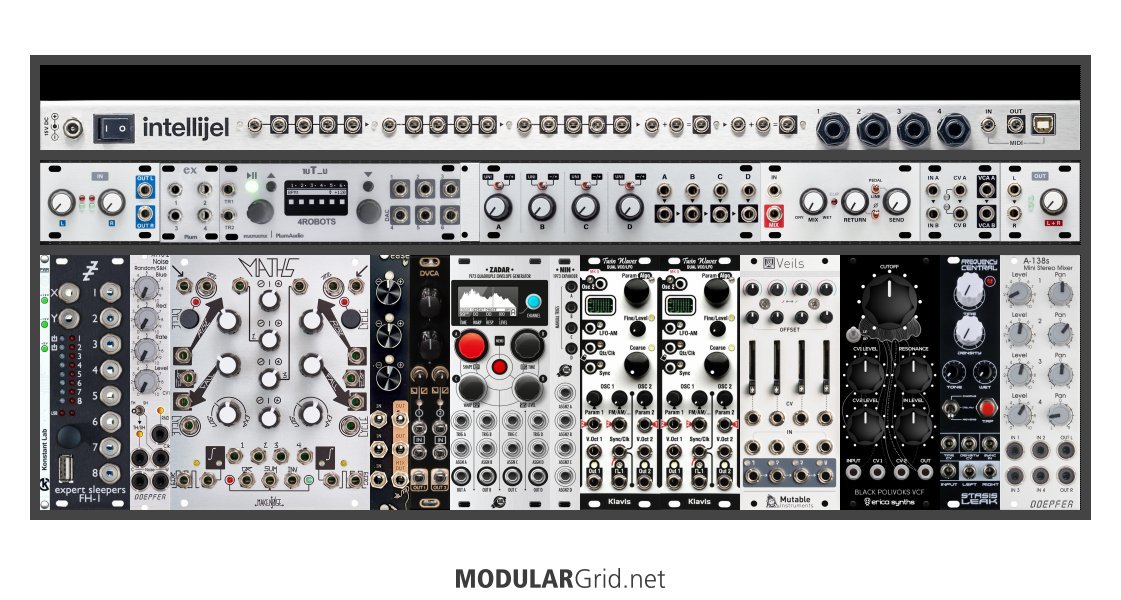First of all, put that Lifeforms synth back in its normal case. When you put something that's already cased and powered into a Eurorack cab, it's worth seeing what that costs. In this case, the Palette 104 costs $399, and the Lifeforms was $599 when it was around, and it takes up 48 hp. Ignoring the tile row in the Palette, this would mean that:
399/104 = $3.83 per 3U hp.
$3.83 x 48 = $183.84 This figure is how much it costs extra to house the Lifeforms, so add that to the Lifeforms' price. Ergo:
$599 + $183.84 = $782.84 This is the ACTUAL cost of the Lifeforms when in the current configuration. And even if you didn't get a case with the Lifeforms, that's still too damn expensive since the Lifeforms has a fixed control density, meaning that you're stuck with the density as specced by Pittsburgh...where if you did this in basic separate modules, you could easily reduce the panel space needed for the same module complement by quite a bit. And in a Pallete, space is at a premium! Hmmm...let's give this a shot...
(several minutes later) OK! This seems to be a lot more functional:

There's quite a few changes besides the Pittsburgh issue. A few functions were shifted into other modules, added a crossmod section for the modulation...
The top row, of course, is the Palette 104 bus module. Then the tiles were switched around quite a bit: Input on the left end, then the two modules that make up the Temps Utile...this is a multifunction thing, with several sequencers, clock outs and so on. I put in a QuadrATT, also...mainly for mixing and inverting mod sources. Next to that is a Pedal I/O, then the Stereo VCA, which can be useful for a number of things...controlling output levels, splitting as VCAs for your Pedal I/O's levels, etc. And then last is the stereo output on the right end. All of the I/Os use the onboard 1/4" jacks.
The 3U row starts with something a bit beefier than a MIDI interface. It IS that...but it has two return channels for situations where you might want the synth to serve as the main clock, etc. And it's class-compliant, so all you need is a class-compliant controller (like a Keystep, etc) and there you are. Next are four "free run" LFOs, then Maths, and then a pair of modules for screwing around with modulation behavior: a Tenderfoot triple attenuverter/mixer and an After Later dual VCA, with the VCA topology based on the Mutable Veils. After this is a Zadar + Nin for your envelopes, then we get into the audio section.
For audio, I went with a pair of Klavis Twin Waves mkii, as these are actually rather complex AND they're quantized...which means you save money and space on not needing a quantizer module while getting a serious VCO complement. These FOUR (yep!) VCOs then feed the four inputs of the Veils, which allows you to either manually control the mix, or you can apply envelopes or other modulation sources for that purpose. Polivoks VCF is next (not a bad choice for a single VCF), then a Frequency Central Stasis Leak gives you your choice of tap delay, chorus, or reverb...and since this has mono-in and stereo-out, it provides your stereo signal via the effects. And last, a Doepfer A-138s is your stereo mixer, with manual level and panning. I would've liked to put in a couple of VCAs post-FX, but if that's really necessary, you can use the VCA tile above.
This is a really open-ended build, which is a bit surprising for a one-row cab, but the tile row really takes up a lot of slack, plus your bus row also gives you buffered mults and adders for a bit more tampering with the CV. Plus you now have a proper sequencer in there that can be used like the Steppy that was there, but also as a CV sequencer, which allows you to set up sequenced ostinati over which you can solo...ala Klaus Schulze, but all in one little cab. Not too shabby, I think!

